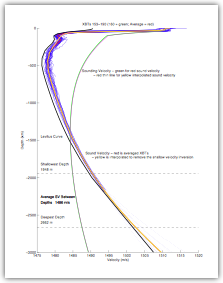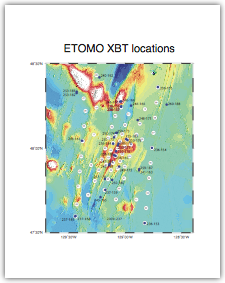
|

|
 |
 |

Appendix A7: MGL0910 XBT Profiles
|
 |
 |
 |
 |
  | Throughout the ETOMO Seismic Study, the ocean’s temperature versus depth was measured using XBT’s, Expendable Bathometers. XBT’s were dropped at various points in the survey area to acquire the temperature. Using this information, the sound velocity was found for the water columns.
|
 |
 |
 |
 |
 |
  | Water Velocity and Sounding Velocity
Graph showing the XBT data collected during the ETOMO study. The blue lines show the sound velocity for each XBT launched. The red line shows the average sound velocity and yellow shows the sound velocity profile with the shallow velocity inversion removed. The green line shows the average sounding velocity and the thin red line is the sounding velocity for the sound velocity profile with the shallow velocity inversion removed - called "smoothed". The black line shows the Levitus curve, which is the average sound velocity for this region. The shallowest OBS depth was 1948 m and the deepest OBS was at 2662 m. The average sounding velocity for the OBSs from this graph is 1486 m/s.
|
 |
 |
 |
 |
 |
 |
  | AverageWaterVel.txt - thick red line
|
 |
 |
 |
 |
 |
 |
  | AverageSoundingVel.txt - green line
|
 |
 |
 |
 |
 |
 |
  | SmoothedWaterVel.txt - yellow line
|
 |
 |
 |
 |
 |
 |
  | SmoothedSoundingVel.txt - thin red line
|
 |
 |
 |
 |
 |
 |
  | The locations labelled in red were failed XBTs
XBT Map.pdf
|
 |
 |
 |
 |
 |
  | Procedure for collecting XBTs
|
 |
 |
 |
 |
 |
  | The MK-21/ISA Bathythermograph Data Acquisition System, employed during this study, is a portable data acquisition system that measures and outputs ocean temperature, conductivity and sound velocity versus depth using expendable probes that are launched from surface ships. The Sippican expendable probe is a small oceanographic sensor, which measures the water temperature. The probes free-fall in the ocean at a known rate while collecting the data.
To launch a probe from a vessel, the canister containing the probe is first inserted into an Sippican LM-3A Hand-Held Launcher. Contacts on the canister provide the electrical connections to the launcher which is connected by cable to the MK21 interface board. When the probe is ready to be launched, the operator pulls a release pin out of the canister, and the probe slides out of the canister into the water. The probe’s hydrodynamic shape allows it to descend through the water at a stable and known rate, enabling continuous calculation of its depth throughout the entire descent. As the probe descends, its sensors continuously measure the water temperature. The measurements are transmitted by a wire back to the MK21 interface board. The wire dereels both from a spool in the probe as the probe descends and from a spool in the canister as the vessel from which the probe was launched moves along the surface. This dual spooling technique enables the wire to remain stationary in the water. Soon after the probe reaches it’s maximum depth, its wire breaks and the probe continues its descent to the ocean floor.
|
 |
 |
 |
 |
 |
 |
  | Detailed table of XBT collection: XBT Table.xls
|
 |
 |
|
 |

